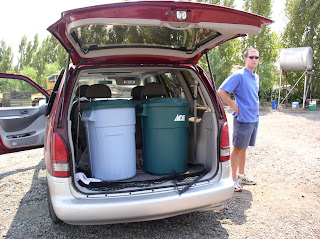In my last post I talked about pressing the Nebbiolo and Zinfandel. That was Sunday Sept. 20. On Monday Sept. 21 I was scheduled to pickup Sauvignon Blanc from Mendocino county.
Monday, Sept. 21: Day 1 for Sauvignon Blanc.

My friend, Joe, has worked out a sweet heart deal for a source of grapes from Mendocino country, and we have made a very good wine from the Mendocino Sauvignon Blanc for a few years now.
One big advantage of getting grapes directly from a vineyard/winery is that they know what it takes from a grape growing standpoint to make good wine.
I'll talk more about grape sources in a later post.
Anyway, the deal Joe has worked out, allows us to get pressed juice, so that the work of crushing/de-stemming and pressing is saved. We just bring our containers to the winery and they pump juice from the large holding tank directly into our containers.
So Monday morning early, Joe, Mike who is also getting the Sauvignion Blanc and I drove to Hopland to pick up the Sauvignon Blanc.
The winery workers know us now, and made short work of pumping the juice into our containers.
We added dry ice directly to our containers to chill the juice and also to provide a layer of CO2 to protect the juice from oxidation during the 5 hours we took to get back home. {A stop in Healdsburg for a Cheeseburger and Truffle fries was mandatory.}

Once home I added more dry ice to my container and left it to sit overnight.
The next morning I racked off the clean juice into carboys, put them into a water bath, and added Champagne yeast. {This is the same process I described for the Malvasia Bianca.}
After 7 days, I added the yeast food and ML culture to help finish off the fermentation.
Temperatures have cooled some in the last few days, so the fermentation may be a bit longer than with my other wines.
It's now Oct. 2 and the fermentation is just finishing. I plan to taste the Sauvignon Blanc today, and rack it if the fermentation is finished, e.g. if I do not taste any sugar left in the juice...













